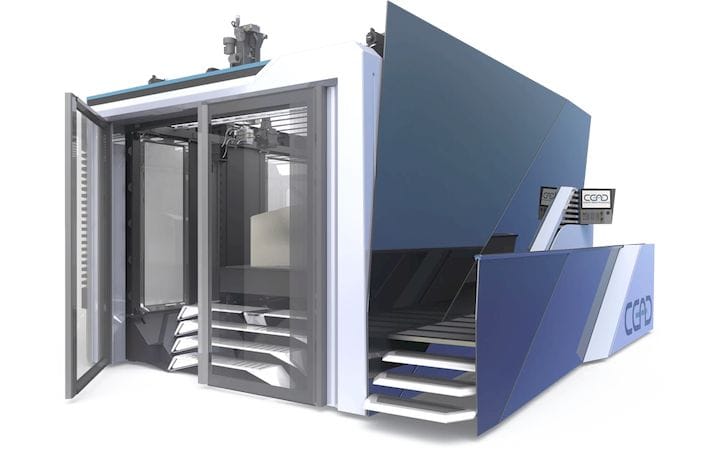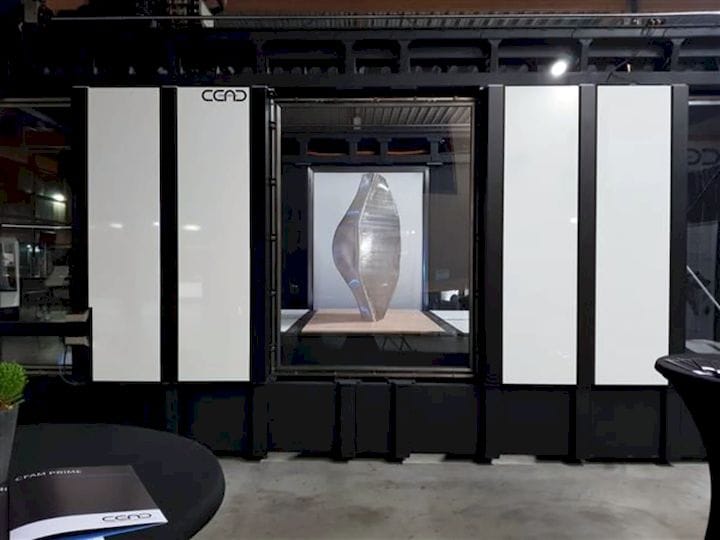
While we recently reported that carbon fiber 3D printing is still in its early stages, we have also learned that development in the space is quickly progressing.
After learning about an Idaho-based company working on continuous fiber additive manufacturing (AM) using industrial robotic arms, we came across a Dutch firm, CEADgroup, that’s deploying large-scale continuous carbon fiber 3D printing.
We spoke to Lucas Janssen, CEADgroup operations director, to understand the new technology and how it came into being.
Large-Scale Carbon Fiber 3D Printing
Before establishing CEADgroup in 2014, Janssen was a co-founder of Leapfrog 3D Printers, which became a well-known Dutch manufacturer of desktop 3D printers. For Janssen and fellow Leapfrog co-founder Maarten Logtenberg, however, the business-to-consumer market was limiting the innovation possible with AM, which is why they started a new firm dedicated to business-to-business manufacturing machinery.
The pair hoped to combine Janssen’s background in industrial design and Logtenberg’s in mechanical engineering, leading to the formation of CEAD, an acronym for “connecting engineering and design.” They began making industrial manufacturing equipment, including custom CNC machines and automated production lines, for their clients. It wasn’t until 2017 that they decided to narrow their focus to 3D printers.
To make a technology suitable for industrial production, the CEAD founders began talking to potential customers about the requirements they would have. They found four important criteria:
-
Size: In order to produce end parts for industrial use, it would be necessary to scale up significantly from desktop 3D printers.
-
Speed: Components need to be made quickly, especially when those parts are large.
-
Strength: Industrial parts are subjected to high amounts of loading and must be strong enough to handle it.
-
Reliability: The system must be able to perform predictable, quality work 24/7.
To address these criteria, CEAD developed continuous fiber additive manufacturing (CFAM), which is capable of 3D printing parts up to 4m x 2m x 1.5m in size at a rate of 15kg per hour. To make those components strong enough, the company turned to composites, specifically glass and carbon fiber reinforcement materials. It’s worth noting here that CEAD is not currently disclosing how it is able to incorporate continuous fibers into prints while achieving such quick speeds and, until then, there may be reason to be skeptical about how it is able to do so. Finally, they aimed for reliability by combining their own expertise with what they believed to be the right tools and materials, such as servo motors and control software from Siemens.
The ability to achieve a material deposition rate of 15kg/hr meant relying on a hopper and plastic granules rather than filament extrusion. The industry has learned already, from the likes of Oak Ridge National Laboratory and Cincinnati Incorporated, that in addition to allowing for the quick melting and extrusion of plastics, the use of a hopper and granules enables a much wider material set. Because the injection molding industry relies on plastic granules, CFAM users can print with materials they are already familiar with.
“By using granules, we can have a much more reliable system. We don’t get clogged nozzles,” Janssen said. “We have a single screw extruder on the printing head that allows working with granules without stopping. It’s a very reliable process that has been fine tuned in the extrusion and injection molding markets for quite some time. We developed the single screw extruder internally, which is suited for all of the different thermoplastics.”

Plastic granules reinforced with chopped carbon fibers are already available. You’ll see companies like Cincinnati Incorporated printing with a combination of carbon fiber and thermoplastics. CFAM, too, can print with chopped carbon fiber, but CEAD has also developed a method for adding continuous carbon fiber or glass fiber filaments during the printing process.
Without going into too much detail about the company’s proprietary process, Janssen was able to explain that CEAD was able to compensate for the immense pressure of the molten plastic deposited from the extruder in order to lay the continuous fiber at the necessary location.
“What we worked around was a system where we could add this continuous fiber without losing the pressure there and without losing the molten thermoplastic material,” he said. “This allows us to combine the stream of thermoplastic material with a continuous fiber, and this continuous fiber enhances the mechanical properties even further.”
The addition of the continuous fiber increases the strength of a part by up to six times. At the moment, CEAD is focused on glass and carbon fiber but will look into additional materials in the long term, including optical glass, copper and steel fibers to add further functionality, such as electroconductivity, to printed objects.
The thermoplastics with which CFAM can print include polyethylene terephthalate(PET), polypropylene (PP), acrylonitrile butadiene styrene(ABS) and polyether ether ketone(PEEK), as well as other high temperature plastics. To ensure even, reliable printing, the flagship CFAM Prime printer features “smart” heating and cooling, wherein thermal cameras feed temperature information to the printing software to actively adjust the system’s temperature.
Read more at ENGINEERING.com











FELIXprinters has released a new bioprinter, the FELIX BIOprinter, which is quite a change for the long-time 3D printer manufacturer.